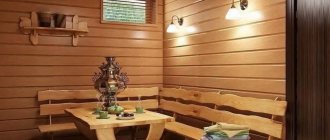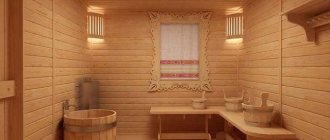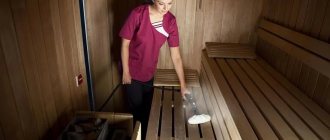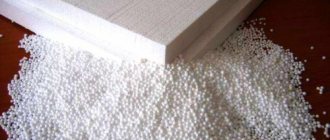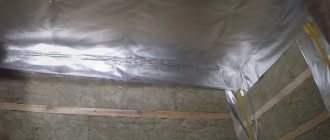Constructing a bathhouse from timber is not a difficult process; much more difficulties will arise in the future during its maintenance and maintenance in excellent condition. After all, the beam of the bathhouse will be in constant contact with moisture and hot steam, which quickly leads to its wear and tear. There is no point in abandoning the construction of a bathhouse from environmentally friendly timber material because of these inevitable difficulties; it is better to arm yourself with knowledge about the protective treatment of wood to prevent its damage.
Protective compounds for external treatment of baths
Before purchasing various impregnations for treating the exterior of a log bathhouse, it is advisable to take into account that the resulting layer does not hide the external characteristics of the wood and preserves its properties. Also, the film must allow fresh air to pass through to the wooden material so as not to interfere with the necessary breathing of the timber.
The bathhouse must be provided with comprehensive protection to protect it from the influence of all existing pests. Impregnations should protect the wooden material from fire, insects and other pests. The decorative properties of the products are also important for a timber bath. To ensure all this, the external walls of a wooden structure should be purchased:
- Bleaches
- Fire retardants
- Antiseptics
- Painting compositions
Types of paints
The abundance of modern paints and varnishes provides various options for solving the problem of how to paint the outside of a wooden house. All types of exterior or facade paint are divided into:
- glaze, i.e. translucent, preserving the appearance and texture of wood, having antiseptic properties;
- covering paints are oil, acrylic and alkyd paints that form an additional layer on top of the wood.
Types of paints and their differences in composition
Materials differ in composition, drying speed, appearance and other characteristics. Experts have not come to a clear conclusion about which paint is best to paint the outside of wooden houses, so you need to choose taking into account the wood from which the house is built (dry, damp, treated, old, etc.) and the climatic features of the area.
When choosing high-quality products, the preservation of wood is ensured for up to 15 years. Such a long-lasting and reliable effect can only be achieved by following the rules of painting and preliminary preparation.
Wood bleaches
If black or blue spots begin to be visible on the walls of the bathhouse, this most likely indicates the appearance of mold or mildew. To return the timber to its original appearance and at the same time get rid of biological pests, special chlorine-based bleaches are made. If the wooden material is not severely affected by fungi and mold, then you can use the composition Neomid 500 or Prosept 50. If the condition of the timber is neglected, then everything can be corrected with the more powerful League BioShield. All these domestic whitening compositions are effective and act for a short period of time.
Manufacturers and product prices
Bath paint is produced by domestic and foreign manufacturers. Its price depends on the material used and the quantity in the jar.
Belinka
The manufacturer's product range consists of paints, glazing compounds, varnishes, and impregnations. They have a wide range of colors, which allows you to bring any design idea to life. When using materials, the structure of the wood is preserved. Belinka produces polyacrylate paints that have water-repellent and vapor-permeable properties.
Tex
Paint from the Russian manufacturer Tex has protective qualities, which guarantees an increase in service life. The company produces soil and glaze antiseptics, drying oils, wax compositions, and fire-retardant impregnation. This allows you to choose an acceptable option for painting the bathhouse.
Tikkurila
The compositions are produced by a Finnish company in accordance with innovative developments. After production, the compositions were tested in harsh climatic conditions. The materials are developed using special components that protect the coating from ultraviolet rays and the wall from excessive absorption of moisture and rot.
The range consists of acrylate, oil and polyacrylate compounds. The paints are certified by the European Union, which ensures their environmental friendliness. The paint has a high cost, which is explained by its excellent technical characteristics. Before applying the composition, areas that cannot be painted are covered.
Saikos
The compositions of the German manufacturer are developed on the basis of natural oils and waxes. This ensures the preservation of the structure for many years.
Fire retardants
Treating a bathhouse made of timber using fire retardants must be carried out without fail, because this building has a high probability of a sudden fire. For fire protection of the external walls of the bathhouse, you can use the compositions Neomid 450-1 and Prosept Ognebio Prof1. They are well absorbed into the wooden material, but when exposed to high temperatures they protrude out, creating a barrier between the flame and the wood. And also preventing access of oxygen to the wood and protecting it from fire. After applying the composition, the timber walls of the bathhouse will acquire the highest degree of protection from fire. In addition, they will be additionally protected from biological pests of wood, thanks to the antiseptic components included in their composition.
Types of premises
Fortunately, there are not many rooms in the bathhouse (in a standard one). Therefore, we will quickly go through the options of what paint to paint the inside of the bathhouse.
Steam room
This is the most problematic room. Many people believe that there is no need to paint anything there at all, but the price for such a decision is rapid darkening of the wood (and almost everyone has a steam room traditionally made of wood or lined with wood), cracking of the wood (this happens more often from poor ventilation during drying), susceptibility to rotting and mold damage (linden and aspen are very unstable species).
So the absence of any protective coatings, on the one hand, should be considered environmentally friendly, and on the other, costly in terms of future repairs.
We believe that a compromise is possible: there are absolutely safe impregnations that protect wood, preventing moisture and dirt from being absorbed. If you have any doubts about whether you should use drying oils, take paraffin oil or another ready-made product designed specifically for the steam room.
You can paint the inside of the steam room with both paints and varnishes, but let them be water-soluble paints. And it would be nice if the label mentioning GOST standards stated that this composition is applicable in the steam room.
Washing
Both silicone and acrylic paints are suitable here. In general, everything that patiently endures the effects of moisture.
Other paints will crack and peel off in pieces under constant exposure to water.
ADVICE! Water dispersions do not tolerate frost well: if the water in the paint freezes, then after defrosting it will lose its quality. Therefore, buy them in the warm season, produced recently.
Impregnations and varnishes are also suitable for painting washing areas.
Again we draw your attention to scuba gear
What paint to paint the rest room and dressing room
These rooms are the least demanding on the composition of paints, so it is best to proceed from budgetary considerations. If it doesn’t run out, you can give yourself a gift and use water-soluble paints again, otherwise, choose a paint that is suitable in color, dullness and durability of the coating from cheaper ones.
Of course, in the second case, it is better to paint when it is possible to ensure the best ventilation and the absence of people. Don't forget to use respiratory protection.
IMPORTANT! Remember that enamels and alkyd paints are fire hazards, but water-soluble paints are not. https://www.youtube.com/embed/cS4–P0UnB8
When should the outer walls of a timber bath be treated?
It is advisable to process wooden material before construction begins, because it may already be infected with various pests. And in this case, most likely, before the construction is fully completed, its strength characteristics will already be damaged. And many companies carry out the initial processing of wood only so that it can be stored and delivered to the customer without incident.
After the log house of the bathhouse has already been erected, all walls should be treated with antiseptic impregnations, outside and inside. It is imperative to impregnate the ends of the timber with special protective agents, which will ensure uniform drying of the material, reducing the degree of cracking. Then the log house must be left at rest for a period of six months. During this time, the timber will dry thoroughly and the bathhouse will shrink completely. And after six months, you can begin to fully treat the log walls with other protective compounds.
How to Paint New Wood Surface
In fact, in order to perform this set of works efficiently, you do not need to have any special skills. It is enough just to do everything consistently and carefully. Now let's move on to the actual process of painting a new wooden house.
At the first stage, the surface of the wood should be completely treated with an antiseptic to increase the degree of protection and also improve adhesion. The paint should be applied to the surface, so let it dry. It may take from two hours to a day. At this stage, proceed to the actual application of paint.
It is important to note that it is best to start painting from the top of the wall, as smudges may form that will have to be constantly smeared if you start from the bottom. Let the first coat dry and then apply the next coat. In total you need to do two or three layers.
How to properly process a log bathhouse from the outside
Correct processing of a log bathhouse built from timber is carried out as follows:
- The wood needs to be sanded, this will eliminate minor defects and unevenness of the timber.
- Then apply several layers of antiseptic to the prepared wooden walls. Particular attention should be paid to the corners of the bathhouse, the joints of the beams and their ends.
- After drying, the surfaces are treated with fire retardants.
- Well, at the end the walls are finished, paints are applied or they are lined with finishing materials.
You can use rollers, brushes and spray guns to treat the walls of the bathhouse from the outside. The highest quality application will be achieved using a brush; such treatment will take longer, but it will be more effective and lasting.
The opinion that there is no need to treat a timber bathhouse with various impregnations, and that it will last for hundreds of years without them, is erroneous. Untreated timber will darken soon after construction, and wood-staining fungi will form on its surface, covering the frame with black and blue spots. In the future, they will not disappear, but will provoke the development of more dangerous biological agents that will rapidly begin to destroy the wooden material. And proper and comprehensive treatment of the walls will allow the bathhouse to last for many years, during which the log house will be beautiful, environmentally friendly and very durable.
Material selection
All stages of construction of a 3 by 4 meter bathhouse
To insulate baths, a wide range of materials of both natural and artificial origin is used. It is noteworthy that to this day, when constructing bathhouses and outbuildings, many owners of personal plots use materials that were used for insulation several centuries ago.
When choosing a material for caulking a log house, you should pay attention first of all to the types of insulation that have such properties as:
- environmental friendliness;
- chemical and radiation inertness;
- resistance to moisture;
- resistance to high temperatures;
- resistance to sudden temperature changes;
- resistance to mold and rot;
- biostability (resistance to damage by insect pests);
- durability (service life).
The inter-crown insulation must provide reliable protection of the building from blowing. The insulation will meet this requirement only if it has sufficient density and elasticity (compliance).
Features of protection of different parts of the steam room
Of course, you can saturate the entire steam room and the furniture in it with one composition. And then coat it with one varnish. Moreover, the products currently produced are rarely limited to one protection function. They usually combine, for example, impermeability with antibacterial effects. But the conditions affecting different parts of the steam room are still somewhat different. Therefore, the processing requirements are also different.
Ceiling
Perhaps the least requirements are placed on this part of the steam room. It is exposed only to the temperature effects of steam. Water almost never reaches it. Therefore, it can simply be coated with a specialized bath varnish.
The ceiling in the bathhouse must be reliably protected from dampness and temperature Source eco-ceiling.ru
On our website you can find contacts of construction companies that offer bathhouse construction services. You can communicate directly with representatives by visiting the “Low-Rise Country” exhibition of houses.
Floor
Unlike the ceiling, all the water that is used in the steam room ends up on the floor. Therefore, the anti-water protection for floor boards must be very good. In addition to antibacterial and anti-water impregnation, it is advisable to cover the floor with a protective layer of varnish. But not every varnish is suitable for the floor. The protective layer should not be slippery. This is a must to protect the floor. Of course, the soles of your feet should not stick to the floor. Do not think that repeatedly coating the floor with varnish increases its safety. The thick layer of varnish cracks and water reaches the wood. In addition, the wood cannot “breathe” through such a coating and will still deteriorate.
When building a bathhouse, do not forget about impregnating the logs on which the floor boards are laid. This, of course, is not the inside of the bathhouse, and there are no special protection requirements for them. But if water gets to them, then sooner or later the floor inside the bathhouse itself will suffer, no matter how well it is protected.
Walls
Most of the impregnation for the bathhouse inside is spent on protecting the lining, which is usually used to line the walls. Therefore, you should not use impregnations and varnishes that, when heated, can release strong-smelling substances. And do not cover it with a protective layer that does not allow the wood to “breathe.”
Shelves and benches
The shelves are the main part of the entire steam room, for which it is, in fact, built. Lying on it should be comfortable, pleasant and safe for health. Wood is a poor heat conductor, so even at high temperatures you won’t get burned by it. It’s another matter if it is covered with a protective film, which can cause a burn if touched. Therefore, it is not recommended to use paints or varnishes for it. It is better to apply a special impregnation for the bath. Often such impregnations are wax-based.
The requirements for the safety and convenience of the surface of shelves and benches are so high that there are bathhouse lovers who believe that wood should be natural for them and not covered with anything at all. But this is still suitable for small bathhouses, where simple shelves can be replaced. And when real furniture masterpieces are built, it is better to find a high-quality composition and ensure their durability.
It’s not enough to create beauty – it also needs to be protected
Principles of coloring
In order for the decorative coating to last longer, you need to take into account the specifics of the work and know how to prepare the surface.
Preparation
Before you start applying paint to the walls, floor, ceiling in the bathhouse or outside, you need to complete the following preparations:
- Caulk the timber walls, cover the cracks with a special wood putty. The walls must consist of several layers - vapor barrier, wooden frame, insulation, foil film, slatted frame, finishing material. Paint is applied on top.
- You need to remove uneven surfaces from brick surfaces and knock down old mortar. Depressions and cracks should be covered with plaster.
After leveling the surfaces, you can begin decorative finishing.
Wood putty (Photo: Instagram / color_174)
Tools
To perform the work you need to prepare:
- Tassels. Can be with natural or artificial bristles.
- Rollers. There are fur, velor, polyamide, foam rubber.
- Sharp knife, scissors.
- Dry rags, solvent.
- Containers for paint.
- Thick polyethylene film.
- Plastic stick.
- Masking tape.
If you need to paint the outside of the building, it is recommended to use a spray gun. With its help you can quickly paint large surfaces.
Features of the work
You need to start painting the walls, ceiling, floor by cleaning the room and preparing consumables. All items that cannot be painted must be covered with plastic wrap. Skirting boards and trim can be sealed with masking tape. The composition is applied in one layer. If it is not enough, you can apply a second one. Metal surfaces must be pre-primed.
Masking tape (Photo: Instagram / detailingmarket)
Preparing the house for painting
By the time of treatment, the wall surface should be clean and smooth. A set of appropriate measures can achieve this. First, you should wash the surfaces using soft abrasives. For example, a brush with plastic bristles can remove the most severe dirt, dust deposits, etc.
Next is washing. At this stage, it is advisable to use special sprayers and washers with high pressure, or use a regular garden hose. In extreme cases, wet cleaning with a rag is performed.
Next, the technological process of preparing the log house for painting involves cleaning it using a hard abrasive. If at the first stage the brush eliminated foreign bodies, then this time the purpose of the mechanical action will be to refine the structure of the tree itself. Use hand sanders or brushes with metal fibers to polish the wood.
Then the washing operation is repeated again, which will complete the preparation for painting.
Requirements
So, let's look at the qualities that a paint suitable for finishing a bath should have.
Facade
Exterior painting of wooden sauna walls
With the outer part of the building the situation is much simpler.
Here are the same requirements that are put forward for painting the same log house:
- Protection of wood from precipitation and excessive humidity. Since this material is susceptible to rotting, the spread of mold and fungi.
Tip: It is recommended to pre-treat wooden walls with an antiseptic. This way you will get greater protection from the destructive effects of dampness.
- Resistance to ultraviolet radiation. After all, the outer part of the building is largely exposed to sunlight.
- Strength and durability. If you repaint the surface every season, the price of such a finish will be too high.
- Fire safety. Wood itself is a very flammable substance, so it is advisable to reduce the possibility of a fire occurring and spreading by any means.
Tip: use fire retardants in combination with paint. They can significantly reduce the flammability of wood.
Interior
Painting a wooden ceiling in a sauna
Article on the topic: How many meters from the fence can you build a bathhouse 2014
How to paint the wooden ceiling, walls and floor of your bathhouse? This already requires the presence of important technical characteristics:
- Ecological cleanliness and absence of toxic fumes. People come to the steam room to relax and improve their health. High temperatures increase the amount of substances released by paints and varnishes. And if they are harmful, they will not only ruin your vacation by having an unpleasant odor, but also, penetrating through steamed pores, will significantly harm your health.
- Increased moisture resistance. If we are talking about a sauna, which is visited at low humidity, then this indicator is not so important. But a Russian bathhouse with its “park” will quickly destroy all types of hydrophobic finishes.
- Resistance to high temperatures. The temperature, depending on the type of steam room, can reach from sixty to one hundred degrees Celsius. Painting wooden walls must withstand such aggressive conditions. Also, we must not forget about the proximity of the stove; an accidental spark should not lead to a fire.
Painting technique
This process generally resembles a regular painting procedure. It is advisable to use a brush as a working tool, which will allow you to treat even hard-to-reach areas.
Experts recommend using two types of compounds when processing log houses. As a preparatory base, you can use one of the antiseptic impregnations in one layer. Next, the main paint is applied in 2-3 layers - oil or acrylic.
Now another question: how to paint a log house with minimal drying time? To do this, you can initially use water-based compositions, the interlayer exposure of which ranges from 2 to 12 hours. For comparison: typical alkyd products require 24 hours for this period.
The painting process itself, regardless of the chosen product, is performed smoothly, but covering the entire target area
It is important to consider that even a modest uncovered area can become a center from which the process of biological destruction of the entire structure will subsequently begin.
